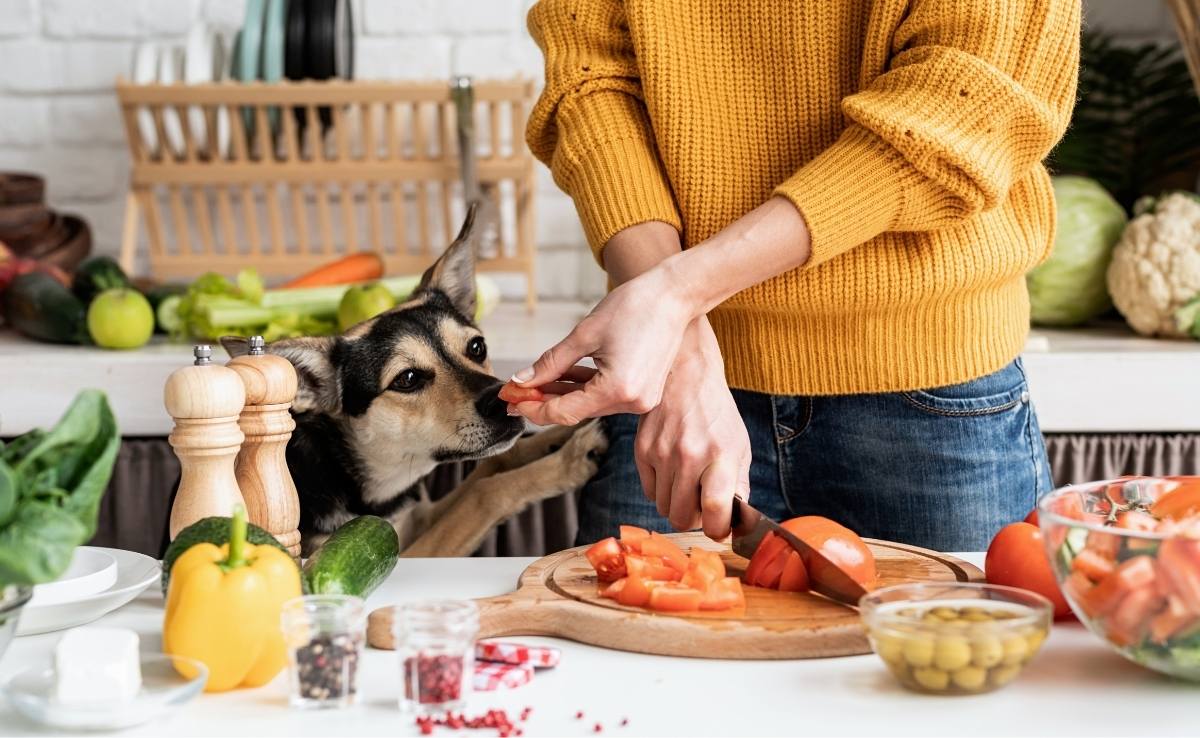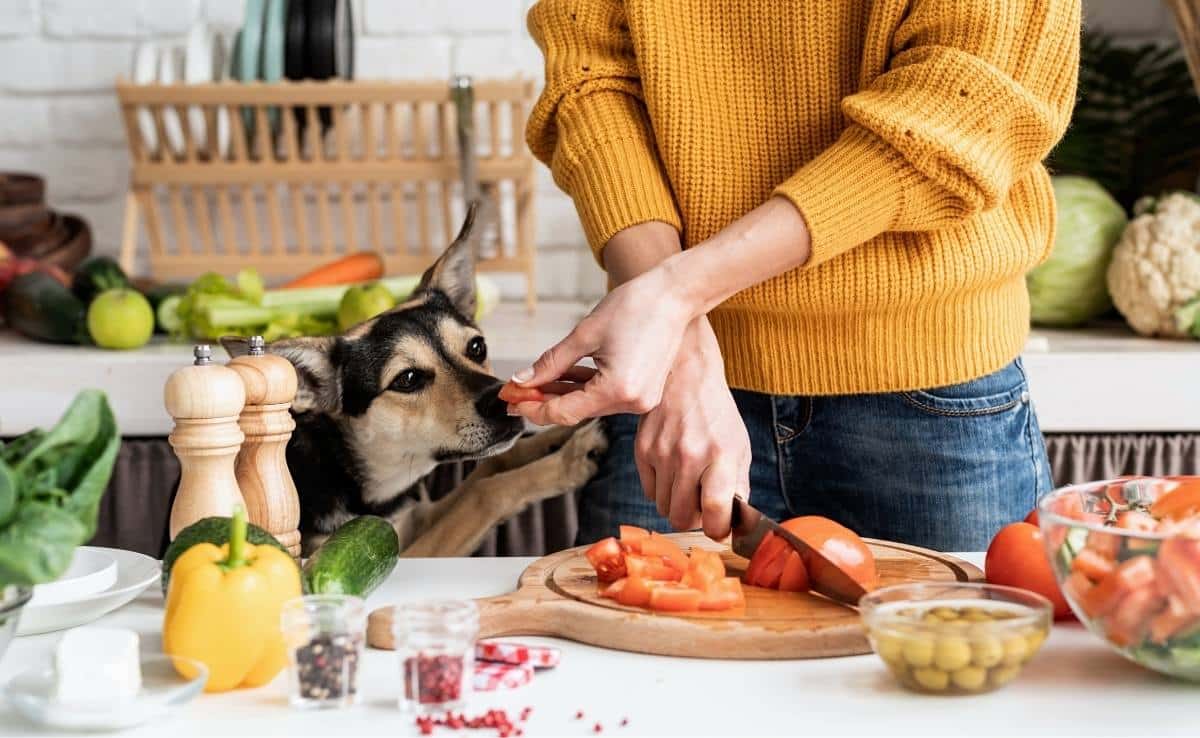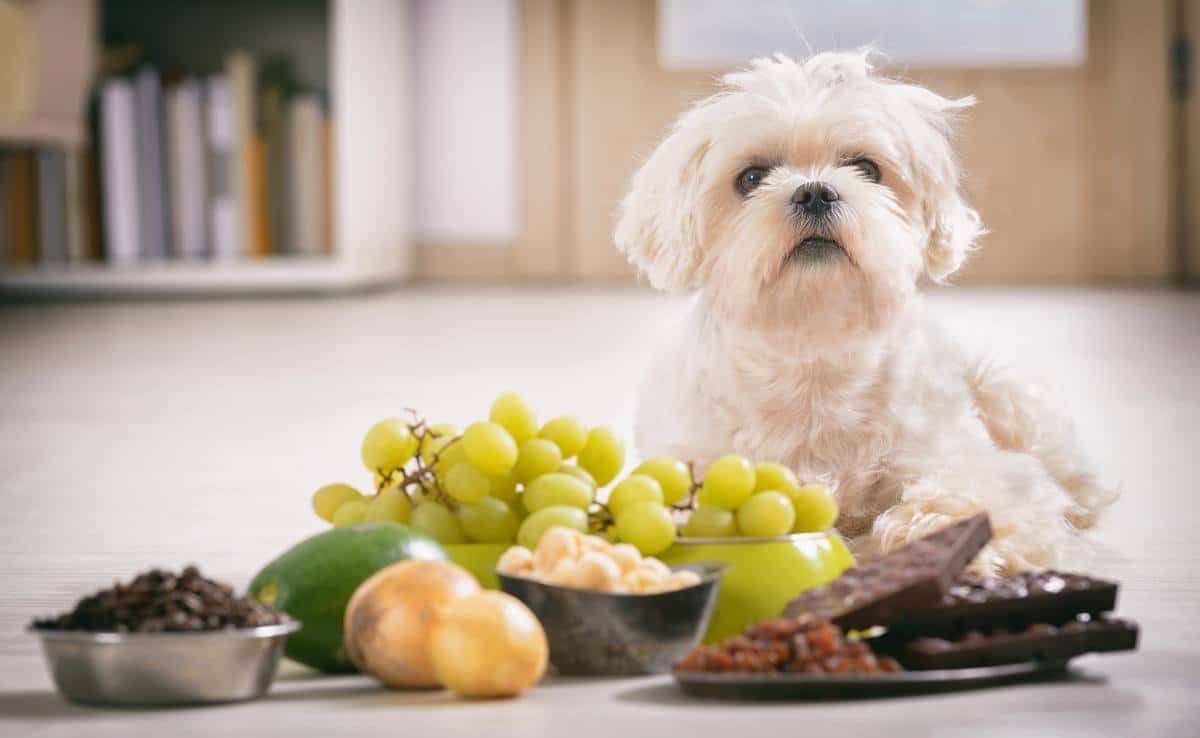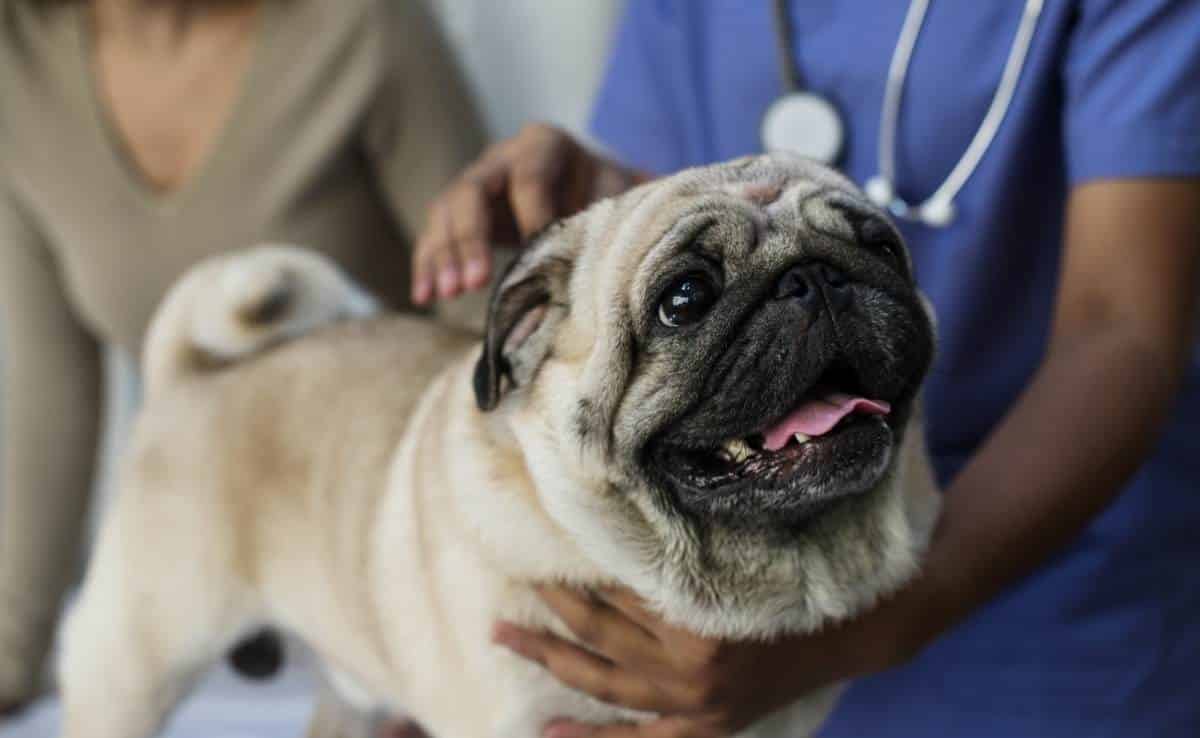

Dogs love to share our food. Any dog parent can attest to that. My dog will literally steal food off my plate, out of my hand, and even try and take bites as I eat. So, of course, I want to be sure that what I am eating is safe in case he gets a few bites. So what human food can dogs eat? Because I know other dog parents have the same questions and concerns, I dug into the research to create this list of 32 dog-safe human foods.
Keep in mind that this list is not comprehensive. While I strive to include as many dog-safe human foods as possible, this list is not all-encompassing. It’s always best to check with your vet if you want to add human foods to your dog’s diet or if you are worried they ate something bad for them.
Human Food Is Not Always Dog-Friendly
Contents

Foods that are perfectly suitable for human consumption may be toxic to your dog, posing a serious threat to their health and well-being. Some foods can cause vomiting, diarrhea, upset stomach, weakened breathing, kidney problems, seizures, and even death. Always err on the side of caution when it comes to feeding human foods to your dogs. You can learn more about foods that are not safe for dogs in our Foods Not To Feed Your Dog guide.
32 Human Food Dogs Can Eat
While many human foods are safe to feed your dog, many are unsafe. As a general rule of thumb, it is far better to be safe than sorry. Avoid feeding your dog any human food unless advised to do so by your vet.
By not feeding your dog human food or table scraps, you’re training your dog to not beg for them in the first place, paving the way for acceptable “food manners.” Those good manners will mean that they’ll bother visitors less frequently at mealtime.
Below is a list of 32 human foods that are safe for dogs to eat in moderation.
1. Apple Slices

Apple slices are safe for your dog to eat and are a great source of fiber and carbohydrates. But be sure to remove the seeds because they’re not safe for dogs. Giving your pup huge amounts of apples isn’t a good idea either; it can lead to gastrointestinal distress and pain. Stick to a few slices as an occasional treat, fresh, unsweetened fruit is best.
2. Bananas

Bananas can be a yummy and healthy treat for your dog to eat. Just be sure to peel the banana before letting your dog have it. The banana peel isn’t toxic to your dog, but it can be challenging to digest and could cause intestinal blockage issues. Just remember to give your dog bananas in moderation. Too much could cause an upset tummy.
3. Blackberries

Blackberries are a safe, sweet treat for your dog. They have a high fiber content, low sugar, and plenty of vitamins and antioxidants. My dog loves to eat frozen berries as a treat on a hot day to cool down. I mix a few in her bowl, and she is a happy girl. Don’t give your dog too many; the extra fiber can cause some stomach issues. Fresh or frozen berries are best, and only give your pup a few at a time.
4. Blueberries

Blueberries can be a tasty and low-calorie treat option for your dog. They contain antioxidants, fiber, and vitamins C and K, all of which help your dog’s overall health. You can use blueberries as a training treat if you’d like. Frozen or fresh berries can add a pop of flavor and nutrition to your dog’s bowl. They, like many other fruits, are high in sugar, so do not overdo it or give them to a pup that has weight issues. These are more of an occasional treat than a daily food.
5. Broccoli

Broccoli is a safe vegetable for your dog to eat and can be nutritious. Give a small amount first to avoid upsetting your dog’s stomach. Keep this one to a minimum, as it can cause some stinky gas and tummy cramps if your pup overindulges. You can learn more about 15 other safe vegetables for your pup to eat in our guide.
6. Brussels Sprouts

Brussels sprouts are safe for your dog to eat, but you may want to avoid including them in their diet because they can cause flatulence. While your dog’s gas may not be harmful to him, it may cause you to leave the room.
7. Cantaloupe

Cantaloupe is a great treat alternative for overweight dogs. It is low in calories and has no fat or cholesterol. It also is a great source of natural fiber. You may want to remove the seeds, though, because they can be a choking hazard for your dog. Don’t let your pup eat the rind, either.
8. Carrots

Carrots (cooked or raw) are a great low-calorie snack and can be a useful training tool. In fact, you can give your dog slices of carrots as a treat and a healthier alternative to other training treats. Stay away from canned or pickled carrots because they contain too much salt.
9. Celery

Celery is safe for dogs to eat, but it should be cut into smaller pieces or cooked to help soften it and prevent choking. If you’d like to start giving your dog celery, we have tips on feeding celery to your dog in our can dogs eat celery article.
10. Cooked Potatoes

Raw potatoes aren’t safe for dogs because they contain solanine which can be toxic to dogs and difficult to digest. However, cooked, unseasoned potatoes are perfectly safe for dogs to eat.
11. Cranberries

Cranberries and dried cranberries are safe for your dog to eat in small quantities. However, your dog may not be a fan of tart fruit. If you find that your dog likes cranberries, feed them in moderation to prevent an upset tummy. Be careful with any dried berry mix, as these often contain raisins, which are toxic to dogs; this includes golden raisins.
12. Cucumber

Cucumber slices can be a healthy snack for your dog. Your dog may like the crunch it offers, which can be similar to other dog treats. Cucumbers are low-calorie, so they may be a good snack for overweight dogs. Just don’t let them dunk them in ranch dressing.
13. Eggs

Dogs can eat cooked eggs, but stay away from the raw ones. Salmonella poisoning and biotin deficiency are two things to be cautious of when feeding your dog raw eggs. Eggs are an excellent source of protein and have a host of vitamins for your pup. Don’t cook eggs in butter, oil, salt, pepper, or other additives. Dogs don’t need those things, and they can be harmful to them as well.
14. Green Beans

You can give your dog raw, steamed, or canned green beans as long as they are plain (leave the salt and other seasonings off). Vets often recommend green beans as a healthy treat option for dogs. We cover all the different kinds of beans dogs can safely ingest in our guide on dogs eating beans.
15. Honey

Your dog can eat honey, but only in very small quantities. Honey is high in sugar, so you do not want to give your pup too much. It is full of antioxidants and can help your pup’s coat to shine; just keep it to an occasional treat.
16. Hot Dogs

Most hot dogs made from beef, chicken, pork, or turkey are safe for dogs. However, it depends on the hot dog ingredients and your dog’s food allergies and intolerances. Plant-based hot dogs are generally safe for dogs to eat. Ultimately, remember to read the instructions carefully so you know if your dog can eat hot dogs.
17. Lean Meat

Lean meat includes the white, boneless meat from chicken or turkey and has had excessive fat removed. It provides a tasty treat for your dog and serves as a great source of protein. If feeding chicken and turkey, remove the fatty skin and cook or boil the meat without seasoning. Learn more about feeding turkey to dogs. We also have a healthy DIY recipe for chicken and rice for dogs.
18. Mangoes

Yes, mangoes are safe for dogs to eat. Just make sure you remove the skin beforehand. While the skin isn’t technically toxic to your dog, it can be difficult to digest, and your dog could choke on it. Remove the pit as well because it contains cyanide, which is toxic to dogs.
19. Oranges

Yes, dogs can eat the flesh of an orange. But be sure to remove any seeds and the peel before giving your dog any oranges. Dogs can also eat clementines (the flesh, not the seeds or peels) but stick to a few sections at a time. Citrus fruit is not something you want your pup to have a lot of, but they can safely eat both clementines and oranges as an occasional treat.
20. Peaches

Peaches are a safe fruit for your dog to eat. The fruit is full of vitamins A and C, antioxidants, fiber, and more. However, peach pits can be poisonous to dogs. Peaches are higher in sugar, so it’s best only to give this food in small amounts.
21. Peanut Butter

Peanut butter can be a wonderful treat for your pup as long as it is the kind with no added sugars or artificial sweeteners. While your pup should not eat a PB&J sandwich, they can have smooth or crunchy peanut butter, and most dogs cannot get enough of it. I have two peanut butter-crazy dogs myself. It is a great way to hide medications or to spread on a lick mat to keep your pooch occupied.
Be sure to pick a brand that is natural, with nothing extra added. You want to be careful not to overdo it, while healthy peanut butter is high in fat. We cover the best and healthiest peanut butter for dogs in this guide.
22. Pears

Your dog can safely eat pears. Pears have many nutritional qualities, including vitamins C and K, fiber, and copper. Like many other fruits, you should remove the seeds because they can contain traces of cyanide, which is toxic to dogs.
23. Peas

Green peas, snow peas, garden peas, and sugar snap peas are all safe for your dog to eat. Peas can be given to your dog fresh, frozen, or thawed, but you should avoid canned peas because they can often have high amounts of sodium in them.
24. Peppers

Bell peppers are okay to feed dogs. Dogs are carnivores and prefer meat to vegetables, but there are some benefits to veggies. For example, green peppers are a low-calorie snack packed with vitamin C and beta-carotene.
Be sure to chop peppers into small pieces because the outer skin can be tough and difficult to chew. Pureeing or steaming the peppers makes them easier to consume and digest. As with most human food, don’t overdo it because too much could lead to sickness. Never give your dog a spicy variety such as jalapeños or hot peppers. Black pepper is not something your pup should have much of, so avoid it when preparing foods at home that you plan to share with Fido.
25. Pineapples

Pineapple is safe for your dog to eat in moderation. It has many vitamins and minerals, which can help boost your dog’s immune system and digestive health. However, pineapple is high in sugar, so moderation is key. Pineapple can be helpful as a way to stop dogs who have a poop eating habit. The fruit contains an enzyme that makes poo taste bad, discouraging dogs from eating it. If you’d like to learn more about safely giving your dog pineapple, read our in-depth guide on feeding dogs pineapple.
26. Raspberries

Yes, your dog can eat raspberries but only in moderation. Too many raspberries could cause your dog to experience some gastrointestinal (GI) problems like vomiting, diarrhea, and constipation.
27. Spinach

Spinach is okay for your dog to eat but only once in a while. It’s high in oxalic acid, which can lead to kidney damage. So while your dog can safely eat spinach, you won’t want them to make a habit of eating it. While considered a superfood for humans, for dogs, it is best only in small amounts and very occasionally
28. Strawberries

Strawberries are safe for dogs to eat. But feed your dog strawberries in moderation. Strawberries are high in natural sugar, which isn’t beneficial for dogs and can cause GI issues. Fresh or frozen berries, with no added sugars, are ideal.
29. Sweet Potatoes

Dogs can eat cooked, unseasoned, peeled sweet potatoes. The skin can be difficult for your dog to digest, and you should never feed your dog raw potatoes of any sort. Sweet potatoes are a good source of natural fiber and antioxidants and are sometimes found in commercial dog foods. Be careful not to offer sweet potatoes too often, as they can contribute to oxalate crystals in your dog’s urine if they eat too many.
30. Watermelon

Dogs can eat watermelon, but the seeds can cause intestinal blockage, so it’s best to give seedless watermelon or remove the seeds. Don’t give your dog the watermelon rind to chew on, as it can cause GI problems. From personal experience, I would recommend feeding your pup watermelon outside as it is very messy. Dogs can also safely eat honeydew melon. The same rules apply as do to watermelon.
31. White & Brown Rice

Cooked white rice is a common recommendation for a dog with an upset stomach. Generally, boiled white chicken and white rice can help firm up stools and nourish a dog that is having trouble getting any nutrition from food as a result of illness. Dogs can also eat brown rice; both can help with stinky gas and diarrhea. Rice is a source of fiber and carbohydrates and is often part of a bland diet recommended for dogs with digestive issues.
32. Yogurt

Dogs can eat plain unsweetened yogurt. Yogurt has plenty of calcium, protein, and probiotics, and it can help with balancing your pup’s gut health. Stay away from yogurt with added fruit and sugars. You can mix fresh berries or veggies in with yogurt to make a cool treat or even a frozen smoothie for your pup. Dogs are often lactose intolerant, so you don’t want to add too much yogurt. Greek yogurt has less lactose and is better for your pup.
Consider Human-Grade, Fresh Dog Food

Many pet parents love the idea of adding fresh nutrition to their dog’s diets but do not have the time to prepare fresh meals. Fortunately, there are plenty of great options out there, formulated by professionals and animal nutrition experts. While not exactly human food, fresh, human-grade dog foods are available for delivery to your doorstep. Our favorite is The Farmer’s Dog. Other choices like Ollie, Nom Nom, and Spot & Tango are also great picks.
View our In-Depth The Farmer’s Dog Review
Our CJ team tried and reviewed The Farmer’s Dog firsthand. Learn more about what they offer and our experience in our in-depth The Farmer’s Dog Review.
What If My Dog Eats Unsafe Human Food Or Has a Bad Reaction?

If your pup has a bad reaction, or you think they consumed something dangerous or are having an allergy response, reach out to your vet immediately. In an emergency, when you cannot reach your veterinarian, immediately contact your local animal emergency clinic or call one of these hotlines to speak to a toxicology specialist and vets who can assist 24/7.
- Pet Poison Helpline at 1-855-764-7661
- North Shore America / ASPCA Hotline at 1-888-232-8870
- ASPCA Animal Poison Control Center at 1-888-426-4435
Note: They may charge a small fee of $59 to $75 per incident and ask for the age, weight, medical history of your pet, concern details, amount when it happened, and current symptoms.
Ask A Vet

Try using our “Ask a Vet” chat feature that is available 24/7 (see the lower right-hand corner of your browser window). You’ll get answers from a doctor within minutes.
Be Proactive & Save Yourself From Expensive Vet Bills
If your dog eats something and gets sick, the vet bill can be tough for pet parents to stomach. Take the proactive step and consider pet insurance (we compare top pet insurance companies in our comparison) before you find yourself rushing to the vet. That way, if an unsuspecting treat becomes a medical emergency, your dog (and your wallet) will be better off. Check out this video explaining what pet insurance is and why it’s worth it.
Keeping Your Dog On A Healthy Diet From Day One
A healthy diet from your pup’s very first days is one of the best ways you can ensure lifelong health and proper development. You will need to select food that meets your pup’s life stage and size. Puppies need different nutrition than adults and seniors. Smaller breeds have much different nutritional needs than larger breeds, so a one-size-fits-all kibble may not be the best choice. Pups with special medical needs, who are overweight, or have diseases like diabetes, may need to be on a special diet. Always discuss dietary concerns with your veterinarian before making any significant changes to your dog’s diet.
Why Trust Canine Journal?
Danielle is a dedicated dog parent with over thirty years of experience with canines. She has long supported animals in need, and all her pups have been rescue dogs. Danielle believes every dog deserves a chance at a loving home and has welcomed many animals with special medical and behavioral needs. As part of the Canine Journal research team, she works alongside a dedicated group to provide dog parents with the most helpful and accurate information to better their pets’ lives.